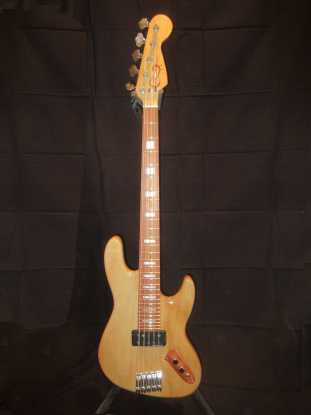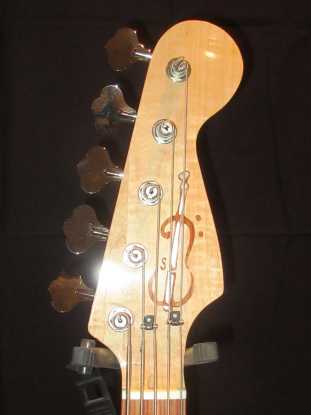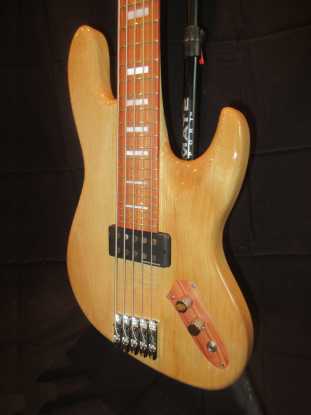Title Home Work Bench Archive Bio/Contact/Links
![]()
Title Home
Work
Bench Archive
Bio/Contact/Links
![]()
|
The Sycamore chambered through-neck J-Bass.
Completed December 21, 2023 |
  Jeff has known me for a lot of years - even playing parties at my home -
and watched a number of instruments through their contruction.
Finally he called me up to say, he wanted his "Dream J-Bass, and to let my
artistic expression come through in the instrument. It should NOT be
a Fender clone. Jeff has known me for a lot of years - even playing parties at my home -
and watched a number of instruments through their contruction.
Finally he called me up to say, he wanted his "Dream J-Bass, and to let my
artistic expression come through in the instrument. It should NOT be
a Fender clone. What I've noticed about the really good players; is they don't expect an instrument to make them a better player. Rather, they pull out the best the instrument can offer as they play it. As a result, they are more open to departures from the run of the mill, or the standard. Jeff's list of "wants" included; 5-string, through-neck, a single passive Music Man "Stingray" style pick, simple controls, and it must be light weight. It should also look good. We discussed wood selection, inlays, pickup  placement,
and varoius other details guitar geeks get into. placement,
and varoius other details guitar geeks get into.The outcome is a one piece through-neck made of perfectly flat sawn flamed Soft Maple, with the taper of the fret board extending and spreading through the body, such that all of the bridge is attached to the wood of the neck. No part of the bridge overlaps the body wings. The strings are also loaded from the back passing through the neck and across the saddles, adding punch and clarity. The body wings are made of American Sycamore (similar in weight to Mahogany). Sycamore is also very showy with a creamy color tone and lace patterns visible across the surface. The lower cut-a-way was deepened towards the end of the fret board, and the horn made smaller, giving greater access to the highest frets, and changing the look of the instrument slightly. The upper horn was extended a little, ballancing both the weight, and the look. Further, the body wings were hollowed out releaving weight and adding resonance. Then air passages of the  same width were drilled through
key areas of the body portion of the through-neck section, conecting these
air chambers. same width were drilled through
key areas of the body portion of the through-neck section, conecting these
air chambers.Tulipwood - a "True Rosewood" (and distinct from the Tulip Tree found here in eastern North America) was used for the fret board. Tulip wood has wonderful variation in color across the grain with reds - orange - cream, is much harder than Indian Rosewood, and much finer cells. Mother of pearl used for the position marks, and in the head stock inlay complete the look. The head stock inlay is copy of a tattoo on Jeff's arm, making this instrument that much more personal.  The tone originating from the Seymour Duncan "Stingray" pickup, plus the sustain of the through neck, is clear and punchy. The pickup is a dual coil design, wired via a Push/Pull/Tone, to provide switchable series vs parallel sound ranges. |
|
Specs |